_th.jpg)
_th.jpg)

.jpg)
.jpg)
Notes from Jean Richard about images he sent April 2006
message 1: some reminders of PBP 1966
_th.jpg)
_th.jpg)

.jpg)
.jpg)
Good morning, Eric,
I have just seen the new pictures: jr03 and jr04 are not like
the original ones, where the late Mr. Magaud and Rolland Bailly
can be seen better, although the main players are obviously Robert
and Maurice. I do not think that there is a particular problem
with these two pictures, otherwise you should have experienced
the same difficulties with all the other ones.
The supporters from Dreux were underway
with a very simple camera producing half dias (18mm x 24mm), a
size which was not very usual, indeed! The main advantage was
a capacity of 72 instead of 36 pictures, today, one can smile
about that, at the age of the digital photography, but in 1966,
it was not negligible.
As I have seen, you still have healthy ducks in Canada: their
brothers of the Lahn River in Germany are very similar, with the
typical green neck. We have some swans, too.
I have been very surprised about the new documents relating to
older editions of PBP. I know the names of these newspapers, but
I have never seen such old issues of them. I understand that your
wife is hunting them through eBay. Maybe it can be helpful to
know further names of sporting reviews. Until the Second World
War, the main one was "Sporting" (weekly). After 1945,
most of the previous french newspapers have been forbidden, rightly
or wrongly, under the pretext of "collaboration" with
the german authorities: regarding sporting newspapers, it was
probably not very relevant; nevertheless, the daily "L'Auto"
became "L'Équipe", and there were two main weekly
reviews: "Miroir-Sprint" and "But et Club-Le Miroir
des Sports", which covered all kinds of sporting activities.
"Route et Piste" was only devoted to cycling events
(Roger Baumann has regularly written articles for this one, I
have to get in touch with him, he is very meticulous -he was bookkeeper-
and I can imagine that he still has much old issues of it).
Today, I send you some reminders of PBP 1966, because I have seen
that you also display all possible things related to PBP. The
finisher medal of PBP randonneurs 1966 was a key-ring, according
to this great fashion of the sixties: everybody has collected
them. I have joined the finisher medal, the frame badge and the
control card of the late Alain Gicquel, who was a friend of mine
from 1965 until his premature death in 1999: I have found them
in his flat, and as he had no family anymore, I have taken all
the reminders of his cycling activities in order to preserve them
to finish in the bin. If you are interested, I have also my own
control cards, obviously, and I can scan more than just the cover
page: you just need to tell me if you would like to have them.
Actually, I am very busy with my new activities, but I cannot
work day and night, and I sometimes need a small change: I hope
I will find further documents for your page.
Best regards,
Jean
_______
message 2: PBP reminders
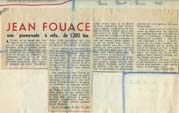

.jpg)
.jpg)
Good morning, Eric, today, I send you some
old articles I have found.
The first one about Jean Fouace, the winner of PBP 1961, shouls
have been published in a weekly piblication for children, probably
"Tintin", named after the young reporter with his
small white dog "Milou" created by the Belgian draughtsman
Hergé.
The second one can be either from the "Télégramme
de Brest" or from "Ouest-France", the two main
daily newspapers in the West of France. This applies also for
the next pictures taken at the check point in Rennes on the way
back to Paris. The first one shows Serge Veau sitting on the pavement
and eating something (probably rice, because he had just discovered
some oriental dietetics) directly from a saucepan: at the same
time, he is massaged by his brother. Then we have the check point
itself: the woman sitting at a table with an alarm-clock in front
of her is Mrs. Lepertel, the wife of the organisator. Further,
we can see Lyli Herse cooking on the bonnet of the 404. On the
right side of the page, there is some participant eating at a
table, but I do not know him. We can see Serge Veau and his brother
again under an other angle, and a group of participants and local
helpers, but again I cannot recognize anybody.
It is always the same problem with non specific newspapers which only intend to transmit some impressions of an event to their readers. The director says: "Today, we have PBP in our town; Mr. X, please go to the check point and take a couple of snapshots.", but obviously, Mr. X cannot know who is who. Nevertheless, you will see in the next days that this Mr. X has sometimes a very lucky hand. I will send you further articles about PBP 1966 and 1971, all is already scanned, but I would not like to produce too big messages and obstruct your mailbox. And anyway, you could not read all of the documents on the same day. I hope you will enjoy these articles and pictures taken by chance.
Best regards,
Jean
_______
message 3: PBP Audax 1966 - control card
.jpg)
.jpg)
.jpg)
.jpg)
.jpg)
.jpg)
.jpg)
.jpg)
Eric,
the evening is going on, here. Now, you get some official documents.
I can imagine that the current control cards do not look like
these older ones. For the Audax event, there were stamps from
the U.A.F., or local cycling associations which provided helpers,
or the stamp of the check-point itself. At the arrival, it was
even the personal stamp of Guy Bossière, the president
of the U.A.F., and on he last page, he has given his signature
for the homologation, together with the late Pierre Kraemer, who
cared to ride PBP alternately as an Audax or Randonneur. You can
find him on the time results in 1956 and 1966, not too far from
the winners. in 1951 an 1961, he finished PBP Audax, according
to the preceding "rule". Pierre Kraemer was vice-president
of the U.A.F. and the highest authority for the homologation of
the brevets His nickname "Le Gaulois" (the Gaul) was
due to his strong moustache. He has added an ironical comment
directed to the late Alain Gicquel "-How much cigars did
you smoke?" It was not a joke at all. Actually, Alain considered
all the brevets like pleasure-trips with a travel agency (he would
have made a good randonneur too, but he enjoyed rather the Audax
organization), and underway, he incessantly smoked big cigars.
Well, it is surely not orthodox, but I would like to say that
in the sixties, none of us was very common, in some way or other
(it applies also for myself!), and you will soon discover curious
things, facts, behaviours or ideas in further documents related
to this period of time.
More documents are following.
Regards,
Jean
_______
message 4: PBP randonneurs 1966 - frame plate and control card
.jpg)
-1.jpg)
.jpg)
.jpg)
.jpg)
.jpg)
.jpg)
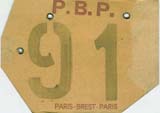
Eric,
now there are my own reminders.
Our frame plates were not so smart as the Audax ones: cardboard instead of plastics, and stencil inscriptions: both sides were the same.
The picture of the control card was some years older: in 1966, the Elvis-like head-dress was already out (but most of the girls still tried to arrange their hairs like Brigitte Bardot...). At the check-points, the time of arrival had to be registered manually (you know already the alarm-clock of Mrs. Lepertel, the procedure was similar everywhere) and only Morlaix had a dating stamp.
On the last but one page, the mention at
the bottom refers to the homologation of the "5,000 randonneurs",
an addition of 200, 300, 400, 600, 1,000, PBP, one Fleche Velocio
(team event) and several other brevets in order to reach a total
of 5,000 km: I made this present to myself for my twentieth birthday,
and was the youngest titular of this distinction.
So much for today.
Till tomorrow.
Regards,
Jean
_______
message 5: PBP Audax 1966
.jpg)
.jpg)
.jpg)
Good morning, Eric,
I have found some reminders of the above event, a flyer which
was distributed during former events in the spring, and a short
article from "Ouest France" or maybe "Le Télégramme
de Brest" with two interesting pictures.
These regional newspapers contain a common part with the general informations from all the world, and local pages which are different in Brest, Rennes, Nantes, and so on. This document is extracted from a Brest of Finistère issue.
The first picture shows the Audax participants arriving in Brest: the capitaines de route are from right to left Jean Hoffmann (U.A.F. a former professional racer), Mr. Vertongen (Belgium), Bernard Guillemin (U.A.F.) who is saluting the town with his right hand, and Jacques Lannoy (U.A.F.) who became some years later president of this association. A second belgian participant (name unknown) completes the first row.
The second picture shows three ladies, Christiane
Neumann (Belgium) wearing a jersey with vertical stripes (designed
for the cycling association of Uccle, a southly suburb of Brussels),
the two other ladies are from the Netherlands, Mrs. Dreuning and
Mrs. Gieselbach (but I do not know who is who); the smaller of
them, in the middle, is wearing a jersey with the national coulours
of her country, the other one has a dark red jersey. I have very
well known Christiane, who was married with a german husband living
in Belgium. Some years later, she was married again with Bernard
Guillemin (first picture) until his death (he was killed on his
bicycle by a car coming out of the fog), and later on she married
Louis Bonny (the leader at the turn in PBP randonneurs 1971):
after so much unhappiness, one can wish that she has found some
peace in the South of France.
So much about PBP Audax 1966.
Till later for further documents.
Regards,
Jean
_______
message 6: a small digression (two non-PBP pictures)
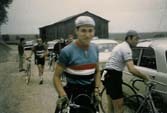
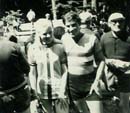
Eric,
the dutch jersey with the red-white-blue stripes was so beautifully
designed that I have bought one in 1967.
I was wearing it at a short veterans race where I was the pacemaker of Jean Hoffmann (U.A.F. jersey). Gilbert Bulté, in the background, is walking in our direction with his bicycle. The second picture was taken at the Col de la République during the Journée Vélocio 1967 by a Belgian friend, André Paermentier, who finished PBP Audax 1966 (he did not smoke cigars, but had always a pipe and tobacco in some pocket of his jersey). Again, I was wearing the dutch jersey, and the young lady was member of the same cycling association as Christiane (her name was Lydia, we met sometimes together by events in France and Belgium: years later, I was told by André Paermentier that she is grandmother...).
As you can see, through the relatively limited quantity of participants, we were building a kind of great family.
This is not a contribution to the PBP history,
but just something for your understanding of the ambiance in the
cycling sphere during the sixties: today, there are several thousands
of participants at the same events: it is not a village which
moves o the road, but a small town.
Till later.
Regards,
Jean
_______
message 7: PBP randonneurs 1966
.jpg)
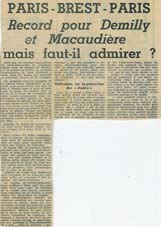
.jpg)

.jpg)
.jpg)
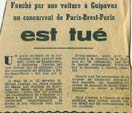
Eric,
here are some articles about the above mentioned event. More to
follow.
Regards,
Jean
_______
message 8: official results of PBP randonneurs
.jpg)
.jpg)
Eric,
this poor jellygraphed piece of paper looks like it would have
be found in some pyramid, but this is not the case. The ACP actually
published the results in this way!
Regards,
Jean
_______
message 9: PBP randonneurs 1966
.jpg)
Eric,
again, some local snapshots taken in or near Brest.
Picture 1 shows the four (not five) leaders on the way back to
Paris (Rolland Bailly had stopped in Brest). Serge Veau leads
the group, preceding Maurice Macaudière, Robert Demilly
and André Triolet.
Picture 2 shows unknown participants during the night.
Picture 3 is very precious, because André Triolet appeared
once every five years. Nobody or very few people knrew what he
has doing in the meantime, but he was always ready for PBP.
Picture 4 shows a participant from Brittany drinking red wine,
actually a very old tradition: in the early Tours de France, when
the stages could be 400 km long or a little more, the revictualling
was the same for all the participants and consisted of a chicken
and a Bordeaux bottle.
Picture 5 shows the four leaders leaving the check-point in Brest.
From left to right, Maurice macaudière is mounting on his
bicycle, Serge Veau is still standing in the street, and puts
something in his jersey pockets, Robert Demilly starts, as well
as André Triolet.
Macaudière
_______
message 10: Re: mial box full
Eric,
well, now there are still big fives (Miroir du Cyclisme).
I think I will send you the common comments to all, and each attachment
separately
in order to avoid any problem.
Jean
_______
message 11: PBP randonneurs 1966
.jpg)
Eric,
Now, this is what the "Miroir du Cyclisme" has published.
I join the cover page of the publication, although it shows other people, from left to right Raymond Poulidor, Franco Bitossi, Rudi Altig, Gianni Motta and the late Jacques Anquetil.
Some comments about the picture at the start:
the first participant who can be seen at the right margin of the picture is Claude Facquet (A.C.B.E.) followed by Serge Veau (wearing a dark jersey) and Maurice Macaudière. On the other side of the street, we can see Mlle Suzanne Pinaul (little picture at the bottom of the page) preceding Tessier (U.V.A.), André Belleville (A.C.B.E.), and André Gayral (U.A.F.). In the background, it is still possible to distinguish Roger Baumann, the tandem Martin (see further picture) and I am the last white spot behind the tandem.
It is particularly interesting to see Facquet and Belleville, members of the same cycling club, on this picture. Like some other riders, Facquet tried to walk in the winter and enjoyed it. He finished all the brevets, the short and the longer ones (between 25 km and 150 km), and intended to participate to Strasbourg-Paris (about 500 km); Belleville should follow and help him on the bicycle. But not only Strasbourg-Paris is a hard job, the qualifying events (about 250 km or 24 hours) are also very tiring: Facquet could be qualified for the main event, but was not strong enough to finish it. he tried twice, with the same deceiving result. Belleville was also very disappointed, and told him: "-Next year, you ride the bike, and I will walk!" And the best of all, he was successful...
The right side of the article shows an already wel known picture, and the tandem Martin (with the same spelling error as on the backside of the Audax finisher medal: "en" bicyclette instead of "à" -"en" would apply to a car, a train or some other closed vehicle it is a common rule in all languages "in" the car, but "on" the bicycle).
In the last message you have received prior to this one, I have just seen I have forgotten to delete Macaudière (last line): it does not make any sense. And a little correction to the picture sent yesterday showing Serge Veau eating and being massaged by his brother by daylight (it was not in Rennes, but in Brest: sorry! The other similar picture of them was taken in Rennes by night: that is correct.
Regards,
Jean
_______
Message 12: PBP randonneurs 1966 : the first attachment of five.
Message 13: PBP randonneurs (2/5)
Message 14: PBP randonneurs 1966 (3/5)
Message 15: PBP randonneurs 1966 (4/5)
Message 16: PBP randonneurs 1966 (5/5) This is the last by one message for today.
.jpg)
.jpg)
.jpg)
.jpg)
_______
Message 17: PBP randonneurs 1966
.jpg)
Eric,
this is the last article I have. It has a little story...
It was published in "Le Perche", a very local newspapers
named after the region around Mortagne-au-Perche. Serge Veau had
heard about it, and we decided to ride to Mortagne in order to
get it. Such newspapers are not big enough to have an office in
Paris, like Ouest-France. Even "Le Télégramme
de Brest" is not big enough for that, but it can be found
at the Gare de Maine-Montparnasse, where the trains come from
and ride to the West of France. It is not a very significant article,
I have let some other things which are around it and are giving
the dimension of the publication: somebody was drunk and could
hardly be stilled. In such rural areas, where never something
occurs, such informations take a great importance, and we have
often to share the attention of the readers with small offenders,
burglars, and so on, because there is no special page for sporting
events.
Indeed, Serge had an other idea, and a very fixed one: he wanted
to try my tandem. Well, on December 21st, 1966, we started from
Paris to Mortagne at midnight (I have told you yesterday that
none of us was very common). It was snowing all the night, and
we reached Mortagne early in the morning at a good speed, but
without any excess. Then, we had to wait until the office of "Le
Perche" opened, we bought the issue we wanted, and ride back
to Paris: the way out of Mortagne is a long acclivity (2 km or
a little more), and all was still normal. As we had it behind
us, Serge asked me: "-Can you let spring the chain to the
right side?" ("-Peux-tu mettre tout à droite?"),
a special way of saying for cycling people which means: "-From
now on, just full speed, and nobody will be spared!" Serge
did not need to repeat this sentence, the 56 x 13 was already
in action, and we began to maltreat the poor machine in the worst
possible way. 20 or 25 km later, we had already lost the first
screws... but we were not to be stopped. The landscape between
Mortagne and Dreux is a succession of small tales, and we had
so much rush going down that we could always reach the next ridge
with the 56 x 13. A few kilometers before Dreux, we became more
reasonable: we had lost so much screws that obviously it would
not be possible to reach Paris in these conditions. We turned
left and went to Serge's home, where we overhauled the tandem.
One day later, we were in Paris again.
So much about the PBP randonneurs 1966: Tomorrow, we will be in
Paris for a couple of days, and I will try to meet Roger Baumann.
Next week, we will be back in Runkel, and I will begin to send
you further documents about the PBP of 1971: I think there are
a lot of pretty things, too.
Till next week.
Best regards,
Jean
_______
Message 18: Re: more PBP articles
Good morning, Eric,
you are right, the chapter PBP 1966 is closed.
I have just seen an error by my part in the last message. I have written: "spring" for "jump" in the story of Paris-Mortagne-Paris. It was a confusion with the german verb "springen" which means "to jump". Sorry! I should use the english language more often.
Now, we will ride "westward",
but just until Paris. Till next week for PBP 1971, and maybe 1951
and 1956.
Best regards,
Jean
_______